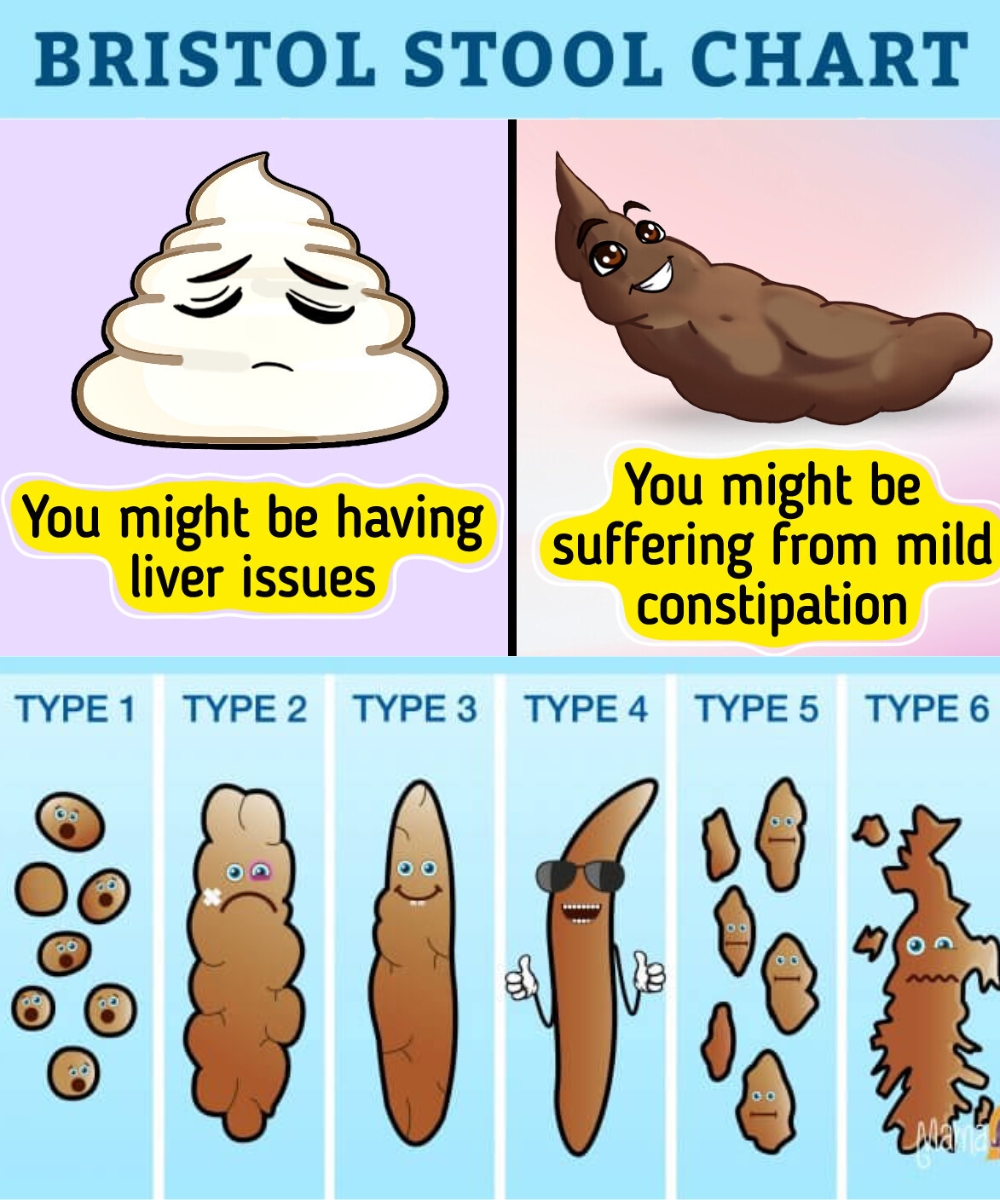1. Color Matters: What Different Poop Colors Mean
The color of your stool is one of the first signs to notice:
- Brown: The normal color due to bile and digestion.
- Green: Often linked to eating green vegetables or food moving too fast through the intestines.
- Yellow: May suggest fat malabsorption or issues with the pancreas.
- Black: Can indicate bleeding in the upper digestive tract or iron supplements.
- Red: Could be a sign of bleeding in the lower GI tract, hemorrhoids, or beets in your diet.
- White or Clay-Colored: Might mean a bile duct blockage or liver issue.
If you notice any unusual color that persists, it’s wise to consult a healthcare provider.
2. Consistency & Shape: The Bristol Stool Chart
Developed by researchers in the UK, the Bristol Stool Chart classifies poop into 7 types:
- Type 1 & 2 (hard lumps): Signs of constipation.
- Type 3 & 4 (smooth, sausage-shaped): Ideal and healthy stool.
- Type 5–7 (soft to watery): Could indicate diarrhea, irritation, or inflammation.
A healthy poop should be smooth, formed, and easy to pass.
3. Frequency: How Often Should You Go?
Normal frequency can range from three times a day to three times a week. What’s important is consistency and comfort. Sudden changes in frequency, such as frequent diarrhea or prolonged constipation, might signal digestive issues.
4. Smell: What’s Normal and What’s Not
Poop doesn’t smell great—but if it’s unusually foul, it might mean:
- Malabsorption
- Gut infections
- Certain foods or medications
- Imbalance in gut bacteria
A drastic change in odor can be a sign something’s off in your digestive tract.
5. Floating vs. Sinking Poop
- Sinking stool is normal and healthy.
- Floating stool may contain excess gas or fat, pointing to malabsorption or digestive issues like celiac disease.
6. Mucus in Poop
While small amounts of mucus can be normal, visible mucus may indicate inflammation, infection, or conditions like irritable bowel syndrome (IBS) or ulcerative colitis.
7. Blood in Stool
This can appear as red streaks, black tar-like stool, or pinkish water. Causes range from minor issues like hemorrhoids to more serious concerns like colorectal cancer. Always get this checked by a doctor.
8. Dehydration and Stool Health
If you’re dehydrated, your colon absorbs more water, making poop harder and drier. Drinking plenty of water and eating fiber-rich foods helps maintain healthy bowel movements.
9. Diet and Lifestyle Tips for Healthy Poop
- Eat a high-fiber diet (vegetables, whole grains, fruits)
- Drink 8+ glasses of water daily
- Stay physically active
- Limit processed foods, alcohol, and excessive dairy
- Manage stress—it can affect your gut
10. When to See a Doctor
See a healthcare provider if you notice:
- Persistent changes in bowel habits
- Blood or mucus in stool
- Unexplained weight loss
- Chronic pain or cramping
- Sudden constipation or diarrhea
1. Color Matters: What Different Poop Colors Mean
The color of your stool is one of the first signs to notice:
- Brown: The normal color due to bile and digestion.
- Green: Often linked to eating green vegetables or food moving too fast through the intestines.
- Yellow: May suggest fat malabsorption or issues with the pancreas.
- Black: Can indicate bleeding in the upper digestive tract or iron supplements.
- Red: Could be a sign of bleeding in the lower GI tract, hemorrhoids, or beets in your diet.
- White or Clay-Colored: Might mean a bile duct blockage or liver issue.
If you notice any unusual color that persists, it’s wise to consult a healthcare provider.
2. Consistency & Shape: The Bristol Stool Chart
Developed by researchers in the UK, the Bristol Stool Chart classifies poop into 7 types:
- Type 1 & 2 (hard lumps): Signs of constipation.
- Type 3 & 4 (smooth, sausage-shaped): Ideal and healthy stool.
- Type 5–7 (soft to watery): Could indicate diarrhea, irritation, or inflammation.
A healthy poop should be smooth, formed, and easy to pass.
3. Frequency: How Often Should You Go?
Normal frequency can range from three times a day to three times a week. What’s important is consistency and comfort. Sudden changes in frequency, such as frequent diarrhea or prolonged constipation, might signal digestive issues.
4. Smell: What’s Normal and What’s Not
Poop doesn’t smell great—but if it’s unusually foul, it might mean:
- Malabsorption
- Gut infections
- Certain foods or medications
- Imbalance in gut bacteria
A drastic change in odor can be a sign something’s off in your digestive tract.
5. Floating vs. Sinking Poop
- Sinking stool is normal and healthy.
- Floating stool may contain excess gas or fat, pointing to malabsorption or digestive issues like celiac disease.
6. Mucus in Poop
While small amounts of mucus can be normal, visible mucus may indicate inflammation, infection, or conditions like irritable bowel syndrome (IBS) or ulcerative colitis.
7. Blood in Stool
This can appear as red streaks, black tar-like stool, or pinkish water. Causes range from minor issues like hemorrhoids to more serious concerns like colorectal cancer. Always get this checked by a doctor.
8. Dehydration and Stool Health
If you’re dehydrated, your colon absorbs more water, making poop harder and drier. Drinking plenty of water and eating fiber-rich foods helps maintain healthy bowel movements.
9. Diet and Lifestyle Tips for Healthy Poop
- Eat a high-fiber diet (vegetables, whole grains, fruits)
- Drink 8+ glasses of water daily
- Stay physically active
- Limit processed foods, alcohol, and excessive dairy
- Manage stress—it can affect your gut
10. When to See a Doctor
See a healthcare provider if you notice:
- Persistent changes in bowel habits
- Blood or mucus in stool
- Unexplained weight loss
- Chronic pain or cramping
- Sudden constipation or diarrhea

